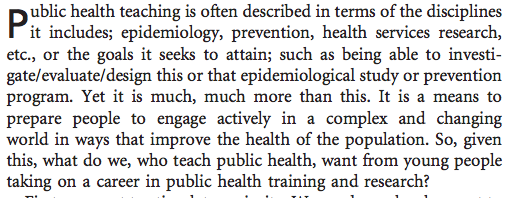In the latest issue of the European Journal of Public Health, a wish list for what public health training should look like in the 21st century is giving by Martin McKee, Professor of European Public Health at the London School of Hygiene and Tropical Medicine: Seven goals for public health training in the 21st century
Having a bachelor and masters degree in public health sciences from University of Copenhagen, I know for a fact that at least in a Danish context public health science communication has not been part of the curriculum for public health students in the later part of the 20th or the first part of the 21st century. None the less, when I saw the headline of Martin McKee’s article, I was hoping that science communication would be an ambition for modern public health training.

Public health science communication is not mentioned directly as one of the 7 goals. In short that goals Martin McKee lists are:
- Stimulate curiosity
- Encourage social entrepreneurs who are willing to take the initiative
- Make epidemiological connections and understand the biological mechanisms behind
- Convey the big picture, expanding Koch’s postulates or Bradford Hill’s criteria of causality with mathematical models to provide evidence of links
- Make public health students literate about what (and who) they are up against
- Engage with key decision makers at all levels and be confident to speak up.
- Ground human rights into public health approaches
Unfortunately, I was to be a bit disappointed. The article starts out well, stating the need to “prepare people to engage actively in a complex and changing world in ways that improve the health of the population”. So how do you prepare people to engage actively in ways that improves their health? Well, in my world that will require that you as a public health professional and public health scholar can actually communicate what you are doing, what your theories are and what findings come out of your hard work. And that you can engage into conversation and discussion with the public and subgroups of the public (e.g. policy makers, researchers in other fields). In short, that you can communicate public health sciences.
For all seven goals, science communication plays a key role, but is only partly mentioned under goal 6, articulating the need for public health people to be confident to speak up and share their knowledge. The only other time communication is touched upon is as an encouragement for public health professionals to not just stay updated on public health news but go beyond the scientific literature:
“More than ever, the public health professional needs to read the Economist, the Financial Times and the Wall Street Journal.”
No suggestion is however broad forward about also contributing and communicating public health through these channels. Shouldn’t public health people aim to let their voice, knowledge and opinions be heard outside the ‘traditional’ public health media?
Another element missing in Martin McKee’s list is the IT reality of the 21st century and how Web2.0 already have and is still changing public health research and practice. He mentions the need for public health people to acquire a great deal more self-confidence and points out how:
“with a fast internet connection, most students could do a much better job of understanding the topics they [politicians and social commentators] addressed”.
But the potential for new ways of communicating and engaging with the public broad forward by social media and other technologies is not mentioned at all.
Make public health science communication the 8th goal
Communication is almost a precondition for all other 7 goals, which is why I would argue that it deserves to be a goal in itself. Public health students should be given competences in communicating what they do, why they do it and taught how communication can benefit not only the people they are trying to help but also their own work (which then again will come to the benefit of the public). Public health is, as Martin McKee opens the article, not just a collection of different disciplines or the goals it seeks to attain. It is much more. Exactly this ‘much more’ however requires communication. Public health science cannot (meaningfully) exist in its own little universe. It only comes to life when it steps out of the public health sphere and meets the rest of the world. This, however, requires that we as public health people are dressed to meet the world and to communicate with it. Let’s make public health science communication skills the 8th goal of public health training in the 21st century.

The article by Martin McKee is unfortunately hidden behind a pay wall, but you read an extract here: Seven goals for public health training in the 21st century.


